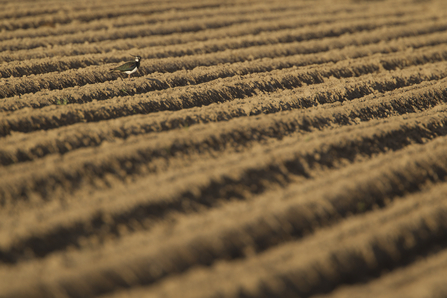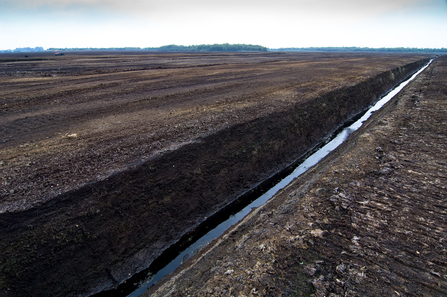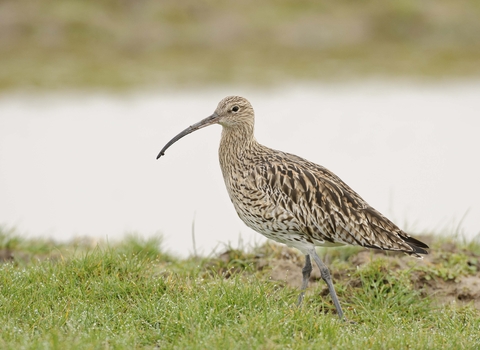Restoring our soils
We depend on soils for growing food. Soils lock-in carbon, help break down or filter out chemicals, hold back floodwater and support an array of life forms. Land management and land use must protect and help our soils.
Why are soils important?
The British Isles have taken 3 billion years to develop into their current form and include a greater diversity of rock and soil types than anywhere else on Earth of comparable size. However, our soils are degraded. All across our countryside soils are being eroded from the landscape and carried out to sea. This is having an impact on wildlife on land, in watercourses, and around our shores. Healthy soils are fundamental to insect life and natural fertility. Good soil health and effective management of soils is vital to our economic future; if we continue to degrade nature through damaging practices we will be less able to grow food or source clean drinking water.

Lapwing on farmland ©Mark Hamblin/2020VISION
What The Wildlife Trusts are doing
We advise farmers and landowners to help them to care for their soils.
We look after 100,000 hectares of wildlife-rich sensitively-managed soils on our nature reserves.
We restore peatland soils, for example by blocking drains and rewetting areas of land. We are also calling for a ban on the use of peat in horticulture.
The Wildlife Trusts lobby for a range of measures which are necessary to help our soils recoverl for example, Government should set a target of increasing organic matter in UK arable and horticultural soils by 20% over the next 20 years (1% a year) and put measures in place to achieve this, such as:
- Ploughing less often or stopping tillage altogether in some circumstances.
- Replacing artificial fertilisers with natural organic matter.
- Ensuring crop rotation, and planting catch cover crops.
Peatlands
Peatlands are amazingly wild places, home to birds, insects and unusual plants that aren't found anywhere else. Peatlands provide benefits for people too; the UK’s peatlands store around 3.2 billion tonnes of carbon, and we get 70% of our drinking water from peatland river catchments.
Peatlands are wetland habitats formed over peat soils. Peat is made up of a mix of partly decomposed plant materials, in particular the 'bog mosses' that are a key feature of peatlands.
More about peatlands as a natural solution to climate change
Types of peatland habitats
Globally there are many diferent kinds of peatland, but in the UK we have three main types:
Blanket bog, generally found in hilly and mountainous areas, is a globally rare habitat although the UK has significant areas. By contrast lowland raised bog covers a much smaller area, and few sites remain intact. Both habitats are unusual as they are entirely fed by rainwater and snowmelt, rather than ground water. Fens, fed by rainwater as well as groundwater, were common in the lowlands but much has been converted to farmland.
Peat takes thousands of years to form as the plant material decays very slowly in wet conditions and gradually becomes compressed into peat - millimetre by millimetre.
Peatlands are tough places to live but wildlife still thrives here including colourful sphagnum mosses, beautiful large heath butterflies and the black darter dragonfly. Peatlands provide important nesting and feeding grounds for many wading birds such as dunlin, curlew and greenshank.

Peat extraction site, Lancashire (Matthew Roberts)
Drainage of our peatlands
Sadly, our peatlands have been suffering for many years and currently around 80% of the UK's peatland are in poor condition. A major cause of damage in the uplands is drainage, where channels are cut into the peat to move rainwater off the land, drying it out to enable sheep grazing, grouse shooting or tree plantations. Damage can also be caused by burning, air pollution and over-grazing by sheep themselves. Many lowland peatlands are drained for farming, and in some lowland areas, peat sadly continues to be cut or dug out to make compost, sold in garden centres or used in commercial horticulture.
The Wildlife Trusts are working across the country to restore these amazing habitats.
Soils and farming
Much modern farming relies on adding nutrients to soils to support productivity. Nitrogen- and phosphate-based fertilisers are applied,and pollution from transport can also add to nutrient levels. However, unhealthy soils and their nutrients are easily eroded from farmland, where they are washed down rivers, altering aquatic and marine ecosystems.
The Wildlife Trusts lobby for a range of measures which are necessary to help our soils recover, including the setting of a target of increasing organic matter in UK arable and horticultural soils by 20% over the next 20 years
Peat in horticulture
Peat has been a major ingredient of compost sold for gardening for many years. This peat is dug out of wild places, damaging some of our last remaining peatlands here in the UK and overseas in places like eastern Europe. This process also releases carbon into the atmosphere, accelerating climate change.
But peat-free compost is available – if everyone used it our peatlands would be safe from this type of damaging practice. It’s often not the first compost you see, or necessarily the cheapest, but if you ask most stores should stock it. By buying peat free you’re helping our precious peatlands and sending a message to manufacturers that people want peat free products. Both are really important.
Go peat free!
-
Only buy peat-free compost for your garden. You can check the packaging for this information
-
If you can’t find any peat free compost, just ask. Consumer demand is important and it sends a message to retailers and manufacturers that people want peat free products.
-
Ensure that any plants you buy are not grown in peat soil (by checking their label)
-
Make your own compost. Not only will you be protecting peatlands but you'll also be helping wildlife in your garden too!


